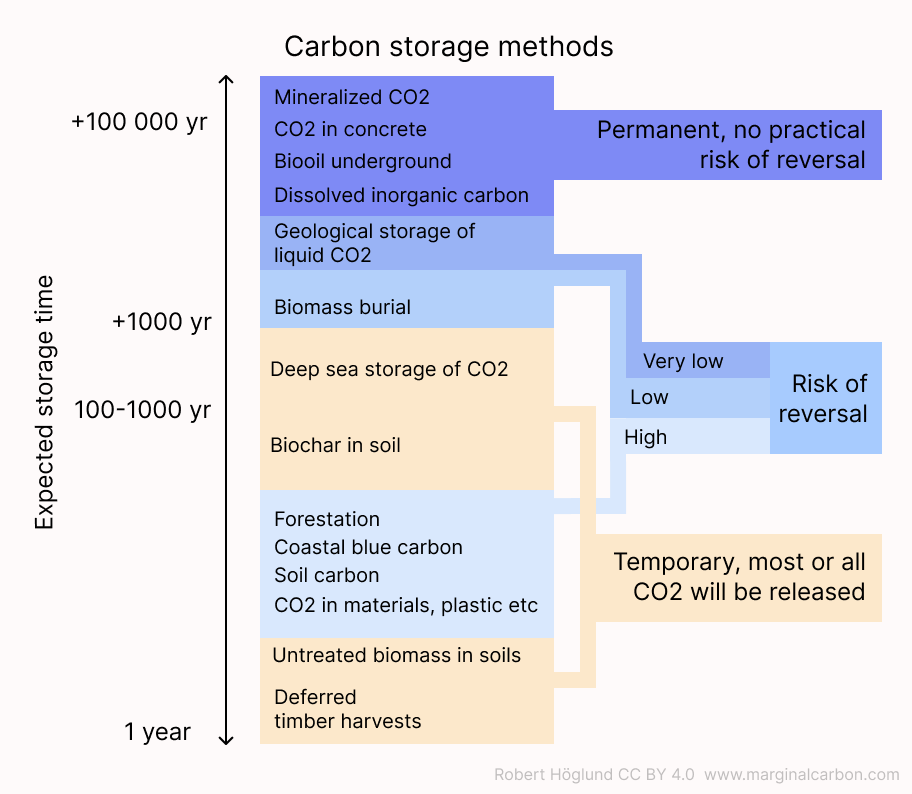Carbon can be temporarily stored for a long time


· 4 min read
The most common way to talk about the longevity of carbon removal is to talk about permanent or temporary removal solutions. That is the vocabulary I have been using too. But in many cases, it does not accurately capture the characteristics of the storage methods available.
A more granular vocabulary around CO2 storage would take into account that some methods are inherently temporary, some are permanent, and some just have a risk of reversal. The graph below is my attempt to map the different important distinctions for CO2 storage.

If, for example, mineralized , the carbon has zero practical risk of being re-released. Biooil stored underground, and carbon stored in concrete (either through CO2 injected or as biochar) are other examples. Dissolved inorganic carbon in oceans could also be seen as essentially permanent storage.
Liquid CO2 injected in geological reservoirs is very durable but not technically permanent. It is likely to remain for thousands of years, but for example, earthquakes could lead to CO2 rerelease. With the way, injection is done and monitored today the risk of reversal is likely very low though. In a similar manner, biomass buried in an anoxic environment can remain inert until disturbed.
CO2 captured by macroalgae that sink in the deep ocean stays away from the atmosphere for over 800 years but is all but certain to be re-released. The same applies to biochar. Once tilled into soils, almost nothing can lead to a sudden re-release of the carbon, but it slowly decays until it is almost all gone after centuries or millennia (depending on its quality and soil conditions).
The main examples here are carbon stored in living biomass, forests, mangroves, seagrass, soils grasslands etc. This carbon is stored in the short carbon cycle. The risk of reversal is high, forests can die, burn- or be cut down, but they can also remain for millennia. Soil carbon gains can be reversed if the land, for example, is tilled, but carbon in undisturbed soil can remain indefinitely. Another example is captured CO2 stored in materials such as wood and plastics. This could be burnt, but also remain for a very long time.
Deferred timber harvests is the main example. Landowners are paid to wait one, or a few years, with cutting down their trees, this is then sold. (NCX and Sky Harvest are two players doing this.) The climate benefit of inherently short-term removal is, however, close to zero if the deferral contracts are not continuously renewed.
“Long-lived carbon removal” is probably the most accurate way to talk about carbon removal methods where it is very likely that the carbon will be stored for at least hundreds of years. When talking about most methods that restore carbon to nature, they can be referred to as having a high risk of reversal or being “vulnerable”.
Does this list depict the most to least valuable storage methods? It could be, but it is not guaranteed. Costs, co-benefits, carbon payback time, possibilities to actually determine how much CO2 is stored, the actual levels of risk of reversal, possible ecological and social risks, and more must also be weighed in when determining what storage method to choose.
Any attempt to simplify carbon storage will produce misleading conclusions. For example, treating forestation as inherently short-lived will underplay its importance. In the same way, realizing that durable, but reversible carbon storage needs to be maintained has practical implications that make a difference when comparing them to permanent solutions.
One interesting example of where the classification matters is emissions from corn ethanol. Most of the life-cycle emissions from producing ethanol comes from carbon lost from soils when new land is used to grow corn. That’s a very different type of emission (originating from the short carbon cycle) than burning fossil fuels (from the long cycle). Restoring carbon to soils elsewhere could be a valid way to offset these emissions. This is a way of doing “like-for-like removal”, returning to the short carbon-cycle what was lost from it. Carbon restoration to the short cycle can also be used to offset other types of land use change emissions, such as cleared forests, and potentially compensate for greenhouse gasses with a short lifetime such as methane. To net out emissions from fossil fuels, long-lived storage away from the short carbon-cycle should be used.
The methods used to restore carbon to soil must be proven to work, though, and forestation must be done in a socially and ecologically responsible way. If carbon credits are sold, they must be additional. Much of the potential from carbon restored to nature will likely not come through the sale of carbon credits, but this is an example of how carbon credits with a high risk of reversal can be used in carbon accounting.
This article is also published on the author's blog. Illuminem Voices is a democratic space presenting the thoughts and opinions of leading Sustainability & Energy writers, their opinions do not necessarily represent those of illuminem.
illuminem briefings

Architecture · Carbon Capture & Storage
illuminem briefings

Carbon Capture & Storage · Public Governance
illuminem briefings

Carbon Capture & Storage · Carbon
The Scotsman

Carbon Capture & Storage · Public Governance
Interesting Engineering

Carbon Capture & Storage · Architecture
Carbon Herald

Carbon Capture & Storage · Maritime